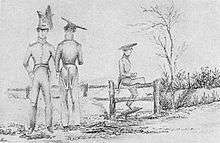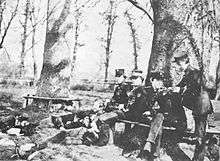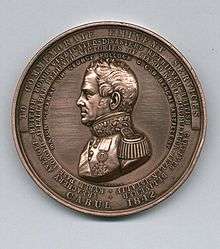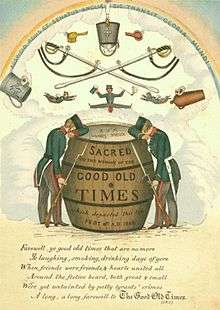Addiscombe Military Seminary
| Addiscombe Military Seminary | |
|---|---|
 East front of Addiscombe Place, the main building of Addiscombe Seminary, photographed in c.1859. Cadets pose in the foreground. The inscription Non faciam vitio culpave minorem can be seen on the entablature | |
| Active | 1809-1861 |
| Country |
|
| Branch |
|
| Type | Training |
| Role | Army Officer Training |
| Garrison/HQ | Addiscombe, Surrey |
The East India Company Military Seminary was a British military academy at Addiscombe, Surrey, in what is now the London Borough of Croydon. It was opened in 1809 and closed in 1861. Its purpose was to train young officers to serve in the East India Company’s private army in India.
The institution was formally known as the East India Company Military Seminary (a name the cadets always disliked) until 1855, when the name was changed to the East India Company Military College.[1][2] In 1858, when the college was taken over by the government, it was renamed the Royal India Military College. Colloquially, it was known as Addiscombe Seminary, Addiscombe College, or Addiscombe Military Academy.
The Seminary was a sister institution to the East India Company College in Hertfordshire, which trained civilian "writers" (clerks). In military terms it was a counterpart to the Royal Military Academy at Woolwich and the Royal Military College at Sandhurst.
History
Addiscombe Place
Addiscombe Place, the mansion house which formed the central building of the later Seminary, was erected in about 1702 by William Draper, on land which he had inherited in 1700 from his aunt, Dame Sarah Temple. Draper's father-in-law was the diarist John Evelyn, who in 1703 pronounced the house "in all points of good and solid architecture to be one of the very best gentleman's houses in Surrey, when finish'd". Its interior included many mural paintings of mythological subjects, supposed to be the work of Sir James Thornhill; while high up on the exterior east front was carved the Latin inscription, Non faciam vitio culpave minorem ("I will not lower myself by vice or fault"). By the late 18th century the house was in the ownership of Charles James Clarke, who leased it to the statesman Charles Jenkinson, Lord Hawkesbury, later 1st Earl of Liverpool. Regular visitors during Liverpool's tenure included King George III and William Pitt.[3]

The military seminary
Following the death of Lord Liverpool in December 1808, Addiscombe Place was put on the market by Emelius Delmé-Radcliffe (Clarke's brother-in-law). It was bought by the Court of Directors of the East India Company for use as a military academy. Although the Company was primarily a trading concern, it also maintained its own army, the officers of which had previously been trained at the Royal Military Academy, Woolwich, at the Royal Military College Junior Department at Great Marlow, or privately. They were now to be trained at Addiscombe. The doors of the Seminary opened on 21 January 1809, although the formal transfer of title of the property did not take place until a year later, on 26 January 1810.[4][5]
The initial purchase comprised the mansion house and 58 acres of land to the south of Lower Addiscombe Road, but a further 30 acres to the north were subsequently acquired.[6] New buildings were added, so that the mansion house, which had originally housed the entire establishment, became a purely administrative block.[7] The additions included barracks, a chapel, a drawing and lecture hall, a hospital, a dining-hall, a sand-modelling hall, a gymnasium, and other service facilities including a bakehouse, dairy, laundry, and brew-house.


Cadets and the curriculum
In the early days cadets entered the Seminary between the ages of 13½ and 16, and later between 15 and 18.[8] They normally remained for 4 terms (2 years), although it was possible to pass the final examination within a shorter period.[9] The initial intake comprised 60 cadets, but the numbers rose to about 75 a year, meaning that there were around 150 cadets in residence at any one time.[10][11] Cadets or their families were required to pay fees (£30 a year when the Seminary first opened; £50 a term by 1835), but these were heavily subsidised and represented only a proportion of the true costs of their education.[12][13]
Initially, the main purpose of the Seminary was to train cadets for the Engineer or Artillery arms of the service, but as an experiment in 1816–17, and more permanently from 1827, "general service" cadets destined for the Infantry were admitted.[14] In all, some 3,600 cadets passed through Addiscombe during the years of its existence: of these, over 500 entered the Engineers, nearly 1,100 the Artillery, and about 2,000 the Infantry, some of whom subsequently transferred to the Cavalry.[15]
The curriculum comprised instruction in the "sciences of Mathematics, Fortification, Natural Philosophy, and Chemistry; the Hindustani, Latin, and French languages; in the art of Civil, Military, and Lithographic Drawing and Surveying; and in the construction of the several gun-carriages and mortar-beds used in the Artillery service, from the most approved models".[16] In practice, the emphasis was on mathematics, and the Seminary was criticised for not including more training in practical "military science".[17] In the 1850s photography was also studied. J.M. Bourne concludes that the Seminary was "not a true military college at all, but a militarised public school" – although he also judges that, by the standards of the age, its record as a military training school was not significantly worse than those of the establishments at Woolwich and Sandhurst.[18]
Cadets were required to wear uniforms at all times, and were not permitted to go beyond the grounds or into Croydon without permission. However, they gained a reputation for indiscipline, and fights with the townspeople of Croydon were not infrequent.[19][20] There was no corporal punishment, but in the early years cadets could be punished by being put in the so-called "Black Hole", and fed on bread and water.[21][22] Until 1829 they worshipped regularly at Croydon Parish Church (marching there each Sunday in uniform, accompanied by their band): after that date they began to worship at the newly consecrated St James's Church, Addiscombe.

Public Examinations and Pollock Medal
Examinations were held twice-yearly in June and December: they lasted about three weeks, and culminated in a Public Examination, a day-long affair of some ceremony before a distinguished audience, which included orchestrated demonstrations of book-learning and of swordsmanship, pontoon-building, and other military exercises; an exhibition of drawings and models; a formal inspection; and the distribution of prizes.[23] The day's events are described in one account as "a performance carefully prepared and rehearsed beforehand. Its object was to make a favourable impression on a carefully selected audience."[24] The Public Examiner, who presided, was an eminent general (see list below); while the audience usually included some of the Directors of the East India Company, and often the Archbishop of Canterbury, who had a residence nearby at Addington Palace.
In 1848 the Seminary began awarding the Pollock Medal to the best cadet of the training season. The award was named after Field Marshal George Pollock. The Pollock Prize was transferred to the Royal Military Academy, Woolwich after Addiscombe was closed.

Closure and development of the site
Following the Indian Rebellion (or First War of Independence) of 1857, the East India Company was wound up in 1858. The College passed into government hands, becoming known as the Royal Indian Military College, Addiscombe, but continued to perform much the same function. With the amalgamation of the Royal and Indian services in 1861, there was initially a proposal that Addiscombe should be retained as a military college. However, the War Office decided that the establishments at Woolwich and Sandhurst were sufficient for their needs, and the College closed in June the same year.
The site was sold on 30 August 1861 for £33,600 to the British Land Company, who demolished most of the buildings.[26] All that remains are two former professors' houses, "Ashleigh" and "India", on the corner of Clyde Road and Addiscombe Road; and the former gymnasium on Havelock Road, now private apartments. The Land Company laid out five parallel roads over the greater part of the grounds, and built them up with villas. The five roads – Outram, Havelock, Elgin, Clyde and Canning Roads – all took their names from soldiers and politicians prominent on the British side in the events of 1857–58, although none was in fact a College alumnus.[27]
Headship
The Seminary's first Superintendent and Head Master was James Andrew, who had previously operated a successful private military academy at Woolwich Common, and who ran Addiscombe until 1822. He was followed for two years by Major W.H. Carmichael-Smyth of the Bengal Engineers, stepfather of William Makepeace Thackeray, whose position was regarded as temporary and who used the title "Resident Superintendent". The headship was then retitled Lieutenant-Governor, and was held successively by Lt-Col Robert Louis Houston (1824–34), General Sir Ephraim Gerrish Stannus (1834–50), and finally Sir Frederick Abbott (1851–61), who had himself been a cadet at Addiscombe.
Notable cadets
- Major-General Augustus Abbott (1804–1867): cadet 1818–19
- Sir Frederick Abbott (1805–92): cadet 1820–22
- Herbert Edward Stacy Abbott (b. 1814): cadet 1829–31
- Major-General Saunders Alexius Abbott (1811–94): cadet 1826–8
- General Sir William Erskine Baker (1808–81): cadet 1825–6: Military Secretary to the India Office.
- Lieutenant-General John Archibald Ballard (1829–80): cadet 1847–8: soldier in East India Company, British and Turkish armies
- Sir Bindon Blood (1842–1940): cadet 1860
- Colonel Thomas Tupper Carter-Campbell of Possil (1838–1900): cadet 1856–7
- Sir James Browne (1839–96): cadet 1856–7
- Sir Proby Cautley (1802–71): cadet 1818–19
- Sir Pierre Louis Napoleon Cavagnari (1841–79): cadet c.1857
- Major-General Sir William Orfeur Cavenagh (1820–1891): cadet 1835–7: Governor of the Straits Settlements
- Colonel John Underwood Champain (later Bateman-Champain) (1835–87): cadet 1851–3: army officer and telegraph engineer
- Sir George Tomkyns Chesney (1830–95): cadet 1847–8
- John Colvin (b. 1794): cadet 1809–10: canal engineer
- Sir Arthur Cotton (1803–99): cadet 1818–19
- Sir Alexander Cunningham (1814–93): cadet 1829–31: army engineer and archaeologist
- Sir Henry Marion Durand (1812–1871): cadet 1827–8
- Major-General Vincent Eyre (1811–81): cadet 1827–8
- Major-General Frederick Edward Hadow (1836–1915): cadet 1852–4
- General Douglas Hamilton (1818–92): cadet 1835–7: big game hunter and artist
- Colonel Sir Arthur George Hammond VC, KCB, DSO (28 September 1843 – 20 April 1919) - recipient of the Victoria Cross
- Lieutenant-General Sir James Hills-Johnes (1833–1919): cadet 1851–3: awarded the Victoria Cross
- Brigadier-General John Jacob (1812–1858): cadet 1826–7
- Sir Samuel Swinton Jacob (1841–1917): cadet 1857–8: engineer and architect
- General Sir Arnold Burrowes Kemball (1820–1908): cadet 1836–7
- Major General Sir Henry Lawrence (1806–57): cadet 1820–22: first Chief Commissioner of Punjab
- General Sir Peter Lumsden (1829–1918): cadet 1846–7: of the Indian Army
- Major General Sir John Carstairs McNeill VC, GCVO, KCB, KCMG (28 March 1831 – 25 May 1904) - recipient of the Victoria Cross
- Major General Donald Macintyre VC (12 September 1831 – 15 April 1903) - recipient of the Victoria Cross
- General Sir George Malcolm (1818–97): cadet 1835–6
- Sir John Frederick Maurice (1841–1912): cadet 1861
- Colonel William Merriman CIE (1838–1917): cadet 1856; won the FA Cup in 1875 with Royal Engineers
- Sir Robert Montgomery (1809–87): cadet 1823–5
- Robert Napier, 1st Baron Napier of Magdala (1810–90): cadet 1825–6
- General Sir William Olpherts (1822–1902): cadet 1837–9: awarded the Victoria Cross
- Sir Thomas Townsend Pears (1809–92): cadet 1823–5
- John Pennycuick (1841–1911): cadet 1857–8: engineer
- Major Eldred Pottinger (1811–1843): cadet 1826–7
- General Sir Harry North Dalrymple Prendergast VC, GCB (15 October 1834 – 24 July 1913) - recipient of the Victoria Cross
- Thomas Price (1842–1911): cadet 1860–61: Australian soldier
- Major General George Alexander Renny VC (12 May 1825 – 5 January 1887) - recipient of the Victoria Cross
- Lord Roberts of Kabul and Kandahar (1832–1914): cadet 1850–51: awarded the Victoria Cross
- Sir Oliver St John (1837–91): cadet 1855–7: political officer in India
- Sir Richard Sankey (1829–1908): cadet 1845–6
- Thomas James Seddon (1804-1868): cadet 1823-25: engineer Bombay Sappers
- Sir Richmond Shakespear (1812–1861): cadet 1827–8
- Richard Baird Smith (1818–61): cadet 1835–6
- Lieutenant-General James Francis Tennant (1829–1915): cadet 1845–7: soldier and astronomer
- Colonel Sir Edward Talbot Thackeray VC, KCB (19 October 1836 – 3 September 1927) - recipient of the Victoria Cross
- Major-General Sir Henry Tombs (1825–74): cadet 1839–41: awarded the Victoria Cross
- General James Travers VC CB (6 October 1820 – 1 April 1884) - recipient of the Victoria Cross
- Colonel Sir Henry Trotter (1841–1919): cadet 1858–60: explorer
- Major-General Sir Alfred Edward Turner (1842–1918): cadet c.1858
- Major-General Charles Waddington (1796–1858): cadet 1811–12
- Sir Robert Warburton (1842–99): cadet c.1860
- Major-General Francis William Ward (1840–1919): cadet 1856–7
- George Dobson Willoughby (1828–1857): cadet 1845–6: detonated the Great Magazine at Delhi during the 1857 Rebellion
- Sir Henry Yule (1820–89): cadet 1837–8: geographer and orientalist
Notable staff
Staff at Addiscombe included:[28]
- Sir Frederick Abbott, Lieutenant-Governor 1851–61
- Dr James Andrew, Superintendent 1809–22
- David T. Ansted, Lecturer in Geology 1845–61
- John Callow, Lecturer in Civil Drawing 1855–61
- Revd Jonathan Cape, Senior Professor of Mathematics 1822–61
- John Frederic Daniell, Professor of Chemistry 1835–45
- Theodore Henry Adolphus Fielding, Lecturer in Civil Drawing 1826–50
- Edward Frankland, Professor of Chemistry 1859–61
- John Christian Schetky, Lecturer in Civil Drawing 1836–55
- William Sturgeon, Lecturer in Science and Philosophy 1824–50
- William Frederick Wells, Lecturer in Civil Drawing 1813–36
Public Examiners
The Public Examiners were:[29]
- Maj-Gen. William Mudge, 1809–20
- Maj-Gen. Sir Howard Douglas, 1820–23
- Maj-Gen. Sir Alexander Dickson, 1824–40
- Maj-Gen. Sir Charles Pasley, 1840–55
- Maj-Gen. Sir John Mark Frederick Smith, 1856–61
References
- ↑ Bourne 1979, p. 206.
- ↑ Broadfoot 1893, p. 657.
- ↑ Paget 1937, pp. 42–4.
- ↑ Vibart 1894, p. 9.
- ↑ Bourne 1979, p. 206.
- ↑ Vibart 1894, pp. 20–22, 310.
- ↑ Bourne 1979, pp. 215–6.
- ↑ Broadfoot 1893, p. 648.
- ↑ Vibart 1894, pp. 15–17.
- ↑ Vibart 1894, p. 16.
- ↑ Bourne 1979, p. 206.
- ↑ Vibart 1894, p. 18.
- ↑ Bourne 1979, pp. 214–5.
- ↑ Bourne 1979, p. 206.
- ↑ Vibart 1894, p. 315. Vibart lists the names of 3,466 cadets at pp. 661–704.
- ↑ Bourne 1979, p. 208; citing the Seminary's official Rules and Regulations.
- ↑ Bourne 1979, pp. 208, 210–11.
- ↑ Bourne 1979, p. 222.
- ↑ Broadfoot 1893, pp. 648–53.
- ↑ Bourne 1979, pp. 220–21.
- ↑ Vibart 1894, pp. 125–6.
- ↑ Broadfoot 1893, p. 649.
- ↑ Vibart 1894, pp. 51–4, 227–34.
- ↑ Vibart 1894, p. 231.
- ↑ Vibart 1894, "Addenda and corrigenda", p. 3.
- ↑ Vibart 1894, p. 310.
- ↑ The roads are named after Sir James Outram; Sir Henry Havelock; James Bruce, 8th Earl of Elgin; Colin Campbell, 1st Baron Clyde; and Charles Canning, 1st Earl Canning.
- ↑ A full list of staff appears in Farrington 1976, pp. 119–21; and further biographical details for many are given in Vibart 1894.
- ↑ Farrington 1976, p. 119.
Bibliography
- Bourne, J.M. (1979). "The East India Company's Military Seminary, Addiscombe, 1809–1858". Journal of the Society for Army Historical Research. 57: 206–222.
- Broadfoot, W. (1893). "Addiscombe: the East India Company's Military College". Blackwood's Edinburgh Magazine. 57: 647–57.
- Farrington, Anthony (1976). The Records of the East India College, Haileybury, & other institutions. London: H.M.S.O. pp. 111–23.
- Gent (ed.), John B. (1987). Victorian Croydon Illustrated (2nd ed.). Croydon: Croydon Natural History & Scientific Society. pp. 20–21. ISBN 0-906047-00-5.
- Paget, Clarence G. (1937). Croydon Homes of the Past. Croydon: Croydon Central Library. pp. 34–45. (mainly on Addiscombe Place)
- Stearn, Roger T. (1994). "Addiscombe: the East India Company's Military Seminary". Soldiers of the Queen: the Journal of the Victorian Military Society. 79: 1–3.
- Vibart, H.M. (1894). Addiscombe: its heroes and men of note. Westminster: Archibald Constable.
External links
- Sutton, Annabelle. "Index of Addiscombe officers". Families in British India Society Database. Retrieved 20 June 2013. (based on Vibart 1894)
Coordinates: 51°22′37″N 0°04′46″W / 51.37693°N 0.07947°W